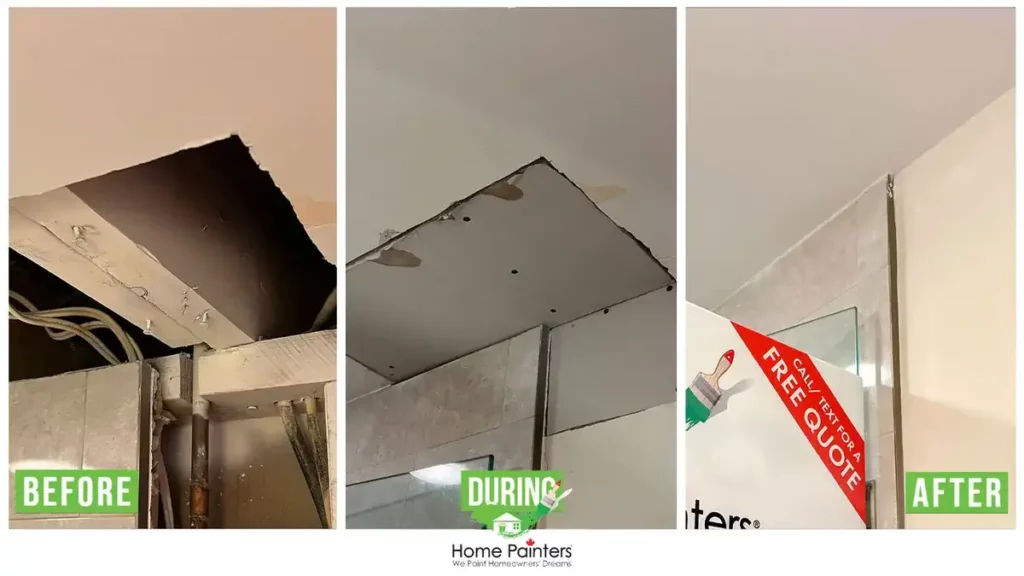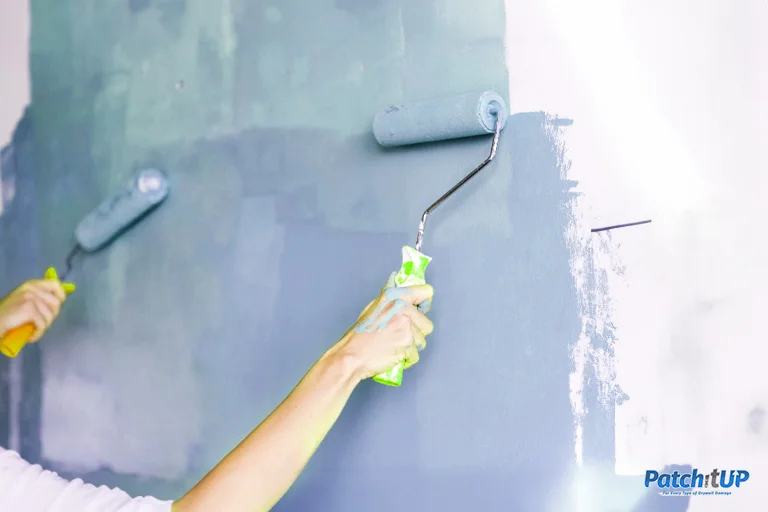Step-by-Step Approaches to Achieving Flawless Drywall Fixing and Setup
Achieving remarkable drywall repair service and installation calls for a systematic strategy. It entails recognizing the various types of drywall and the tools necessary for the task. Proper location prep work is crucial prior to beginning any job. Interior Painting. Each action, from patching holes to mounting new sheets, demands attention to information. The process does not end with installment; completing methods are important for a sleek appearance. The following actions will guarantee a seamless result, but just what do they involve?
Comprehending Drywall Types and Devices Needed

The installment tools are similarly crucial. An utility knife is important for cutting drywall sheets, while a drywall saw can assist in making precise cuts for electrical outlets or components. T-squares assure precise measurements, and drywall screws or nails protect the panels to wall surface studs. Furthermore, a drywall lift can help with the installment of huge sheets, decreasing physical strain. Familiarity with these kinds and tools appreciably adds to the performance and high quality of drywall tasks.
Preparing the Area for Repair Service or Setup
Preparing the location for drywall repair or setup is vital to ensure a reliable and smooth process. Initially, the surrounding area needs to be free from furniture and various other challenges to give sufficient working space. This not only ensures safety and security however additionally stops damage to personal belongings. Next, it is necessary to cover the flooring with ground cloth to catch any debris or dirt produced throughout the job.
Furthermore, the walls need to be inspected for any kind of loosened paint or wallpaper that may hinder attachment. Getting rid of these components produces a clean surface area for the new drywall. Before start, it is a good idea to switch off power to electric outlets or components around. Ensuring sufficient lights in the work space will better improve exposure and emphasis throughout the repair or setup procedure. drywall contractors. By diligently preparing the location, one prepares for a successful drywall task
Step-by-Step Refine for Patching Holes
:max_bytes(150000):strip_icc()/SPR-solutions-to-common-drywall-problems-p2-4120949-not-on-stud_53719-051c5226ba8f478086c3994975acf8c9.jpg)
Patching openings in drywall requires a systematic approach to ensure a seamless repair work. The very first step involves reviewing the size of the hole. For little holes, a patching substance may be adequate, while bigger openings necessitate a patch. Next, the damaged area should be cleaned and prepared by removing any type of loose particles.
For tiny holes, applying spackling substance with a putty knife is suggested, smoothing it over the opening and feathering the sides. Once dry, fining sand the area ensures a smooth finish. For bigger holes, a drywall patch must be reduced to dimension, positioned over the hole, and secured with screws. After mounting the patch, the exact same spackling process is duplicated, complied with by sanding.
Finally, the patched location needs to be topped and repainted to match the surrounding wall surface. This careful procedure guarantees a professional appearance and expands the life-span of the repair service.
Installing New Drywall Sheets: A Comprehensive Overview
Setting up brand-new drywall sheets calls for cautious preparation and execution to ensure a tough look at here now and visually appealing coating. The area has to be gauged properly to identify the number of sheets required. It is crucial to choose the right density, normally 1/2-inch for indoor wall surfaces and 5/8-inch for ceilings or fire-rated applications.
Next off, the studs or framework should be inspected for any irregularities, ensuring they are aligned and effectively spaced. When putting the drywall sheets, they need to be placed flat to minimize seams and enhance structural integrity. A drywall lift can be useful for overhead setups.
Attaching the sheets with drywall screws at proper intervals makes certain a safe and secure installment. It's right here important to countersink the screws slightly below the surface to prepare for the finishing procedure. Adhering to these guidelines will cause a strong structure, ready for the next action in drywall finishing.
Finishing Touches: Taping, Mudding, and Sanding Strategies
Once the drywall sheets are securely fastened, the focus shifts to the finishing touches that will offer a refined look. This procedure starts with taping, utilizing either paper or fiberglass fit together tape to cover the joints between sheets. The tape ensures a smooth shift, minimizing the danger of splitting. Complying with insulation, mudding is crucial; a joint substance is used over the tape to fill up gaps and create a seamless surface area. Generally, multiple coats are essential, every one feathery out additionally than the previous to reduce visibility.
After sufficient drying out time, fining sand is the last step in accomplishing a flawless finish. A fine-grit sandpaper is used to smooth the dried substance, assuring there are no flaws or bumps. Attention to detail throughout this phase is significant, as it significantly impacts the total look of the wall. The end outcome must be an even, professional-looking surface area prepared for priming and painting.
Regularly Asked Inquiries
Exactly how Do I Choose the Right Drywall Density for My Job?
To choose the appropriate drywall density, think about the task's purpose, place, and structural demands. Criterion thicknesses consist of 1/2-inch for basic use and 5/8-inch for fire-rated applications, making certain longevity and compliance with structure codes.

Can I Set Up Drywall Over Existing Drywall?
Yes, setting up drywall over existing drywall is feasible. Nonetheless, it is essential to assure the underlying surface area is complimentary and safe from damage. Correct attachment and consideration of density are imperative for a successful installation.
What Are the most effective Practices for Drywall Disposal?
The very best techniques for drywall disposal include recycling when feasible, utilizing neighborhood waste administration services, and following standards for harmful materials if appropriate. drywall contractors. Properly labeling and securing waste assurances compliance and safety and security during disposal
The length of time Should I Wait for Mud to Dry Prior To Sanding?
Typically, one need to wait 24 hr for drywall mud to completely dry before fining sand. Nevertheless, drying out time can vary based upon humidity and temperature level, so looking for a company texture is suggested prior to proceeding.
Exist Eco-Friendly Drywall Options Available?
Yes, environment-friendly drywall options are offered. These choices frequently make use of recycled materials, low-VOC adhesives, and lasting production methods, lowering environmental influence while supplying efficient insulation and sturdiness for various building and construction and remodelling projects.
An energy knife content is crucial for cutting drywall sheets, while a drywall saw can assist in making precise cuts for electrical outlets or fixtures. Preparing the area for drywall repair or installation is important to assure a reliable and smooth process. Covering holes in drywall needs an organized technique to guarantee a smooth repair. Setting up brand-new drywall sheets needs mindful planning and execution to assure a visually attractive and tough finish. Yes, installing drywall over existing drywall is possible.